When we returned from the Black Pool to the nearby Blue Pool, Sneža and I left our small backpacks in a corner, so to speak, and then took our clothes off for we were ready – we already had our swimsuits on. I could hardly wait to get into the water, but first I had to go barefoot down the rocks very carefully (the hiking boots remained with the rest of my things). I managed, of course, and then I stepped into the water. The good thing was that the bottom was covered in sand and that felt very good on my feet, but on the other hand the water was absolutely icy. I stopped for a moment wondering what to do next, but then I decided to go all the way in. So, I wetted slowly the parts of my body that were outside the water in order to get them used to the wet coldness, going in more and more deeply and then I immersed myself! Brrr... Still, after a few seconds, the body reacted better, so I could even swim a little and then I also started to enjoy intensively since the water was fresh and clean, I was surrounded by fantastic nature and it was a privilege being in such a place, especially without any crowds. Soon Sneža followed suit, with the same impressions as mine, and then we floated a little in one place in order to pose while the guide took some photos of us.
 Bathing in the Blue Pool
Bathing in the Blue Pool
Then we got out and returned to our things where we dried a little using the towels we had brought with us and then we put our clothes on. It also felt good standing there in the sunlight and warming ourselves a little in that way. Then a young man who was there, too, decided to follow in our footsteps, but he also asked us to take photos of him while he was in the water, so we stayed there for a little while, but just enough for the shadow to move a little, allowing us to see the “pool” lit by the Sun. However, although the water still did not have the proper blue colour, it was certainly crystal clear and transparent.
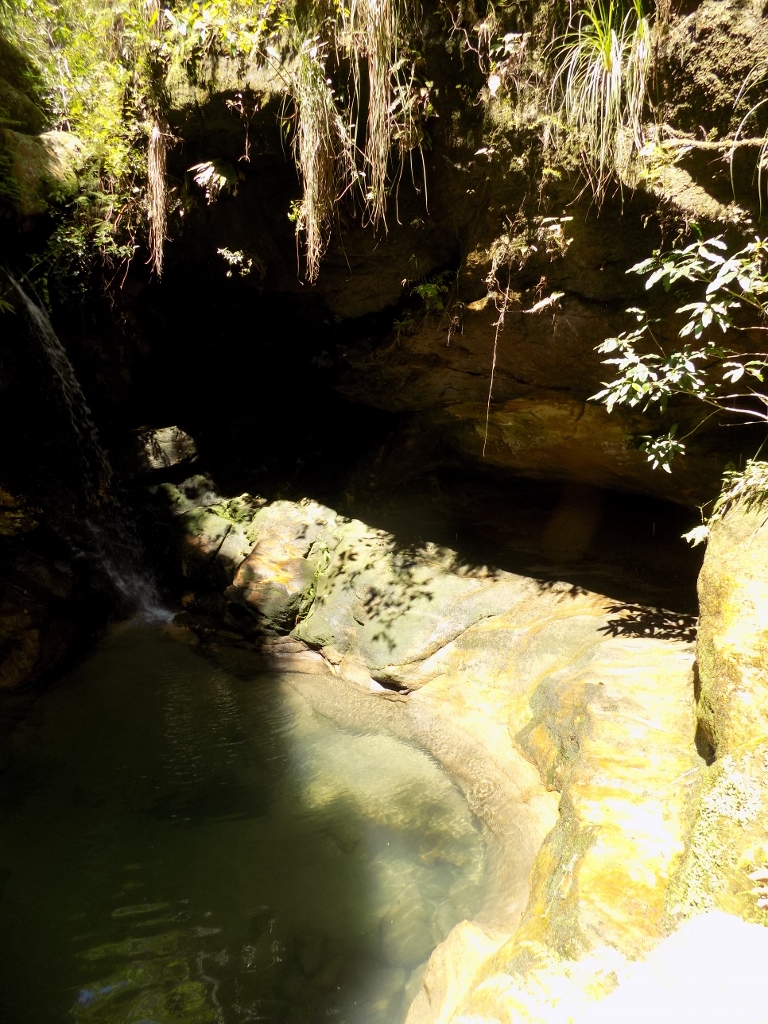 Blue Pool partially lit by the Sun
Blue Pool partially lit by the Sun
Then, following our guide, we headed back going along the same path that had brought us to the natural pools. As the Sun was moving towards its zenith, so the other parts along the path started to be lit, including a part of the canyon, as well as a “bridge” that helps visitors cross from one bank of the main river along which we walked to the other.
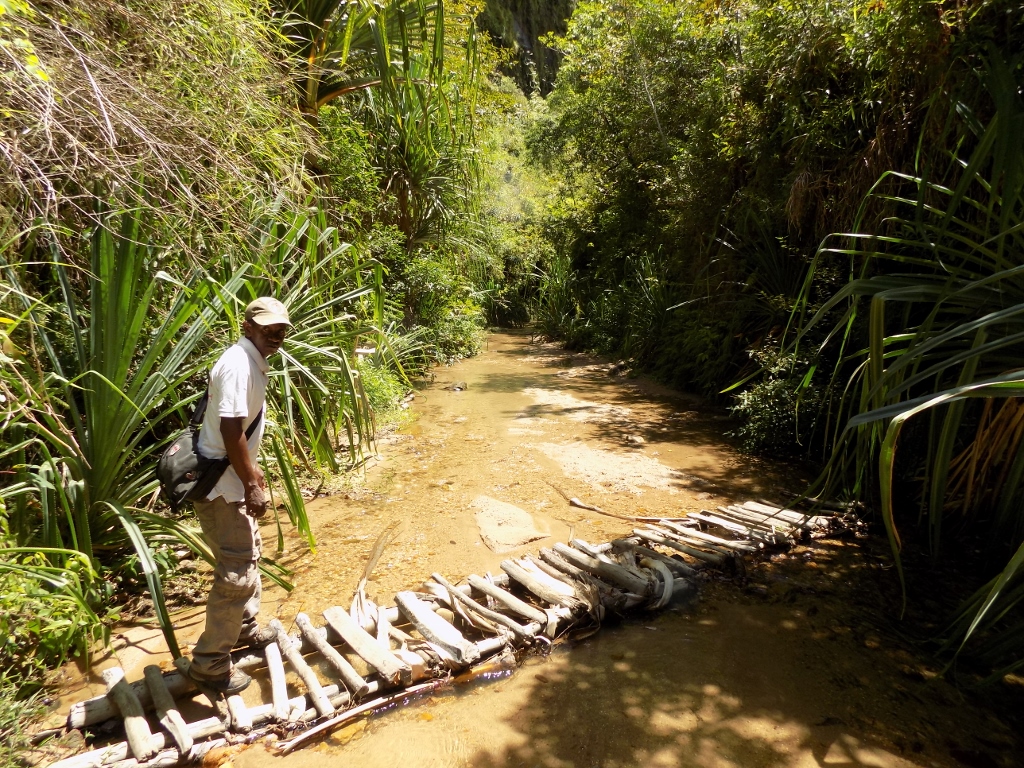 Our guide and the bridge over the river
Our guide and the bridge over the river
At some point, however, we turned from the main trail and started to go uphill following one obviously completely artificially made path. In addition to the climbing itself, we also had a problem in the fact that it was significantly warmer now, with the habitually high air humidity.
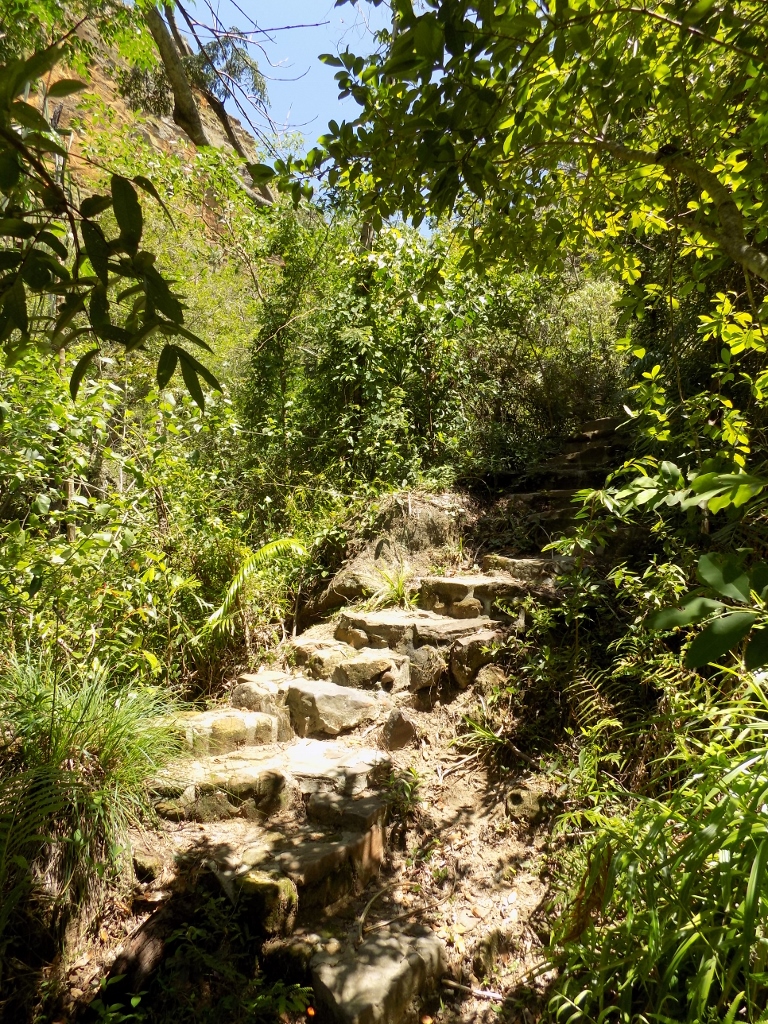 Path through the forest
Path through the forest
However, I had some good excuses to take breaks, thus catching my breath. Namely, in a couple of places I noticed some local residents and thus I stopped trying to take photos. To start with, there was a dragonfly called Jewel Elf (Calophlebia karschi).
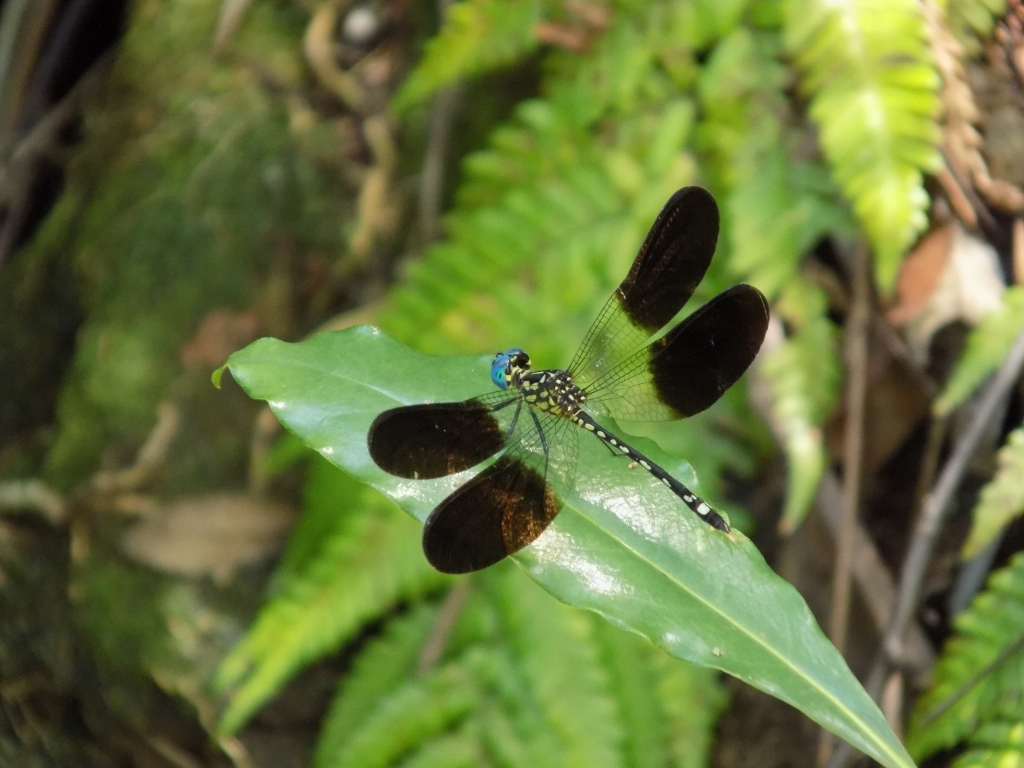 Local Jewel Elf
Local Jewel Elf
There was also a Madagascan wagtail (Motacilla flaviventris), an endemic bird which was not too keen on posing, so I had to “chase” it without scaring it and thus the photos are such as they are.
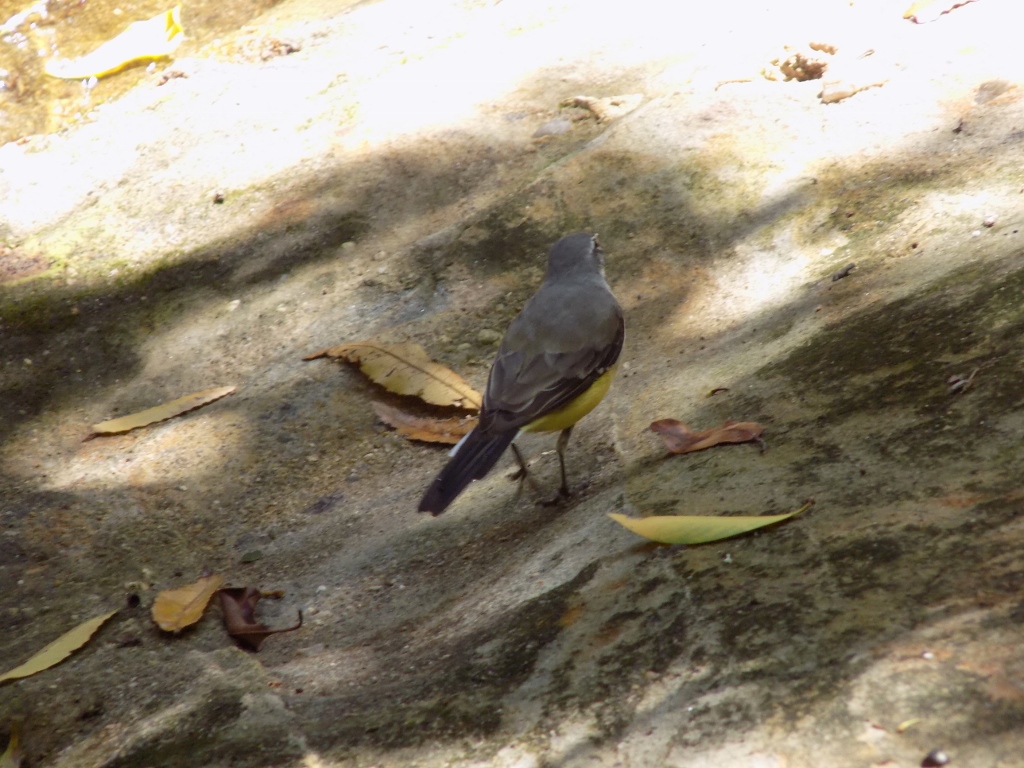 Madagascan wagtail
Madagascan wagtail
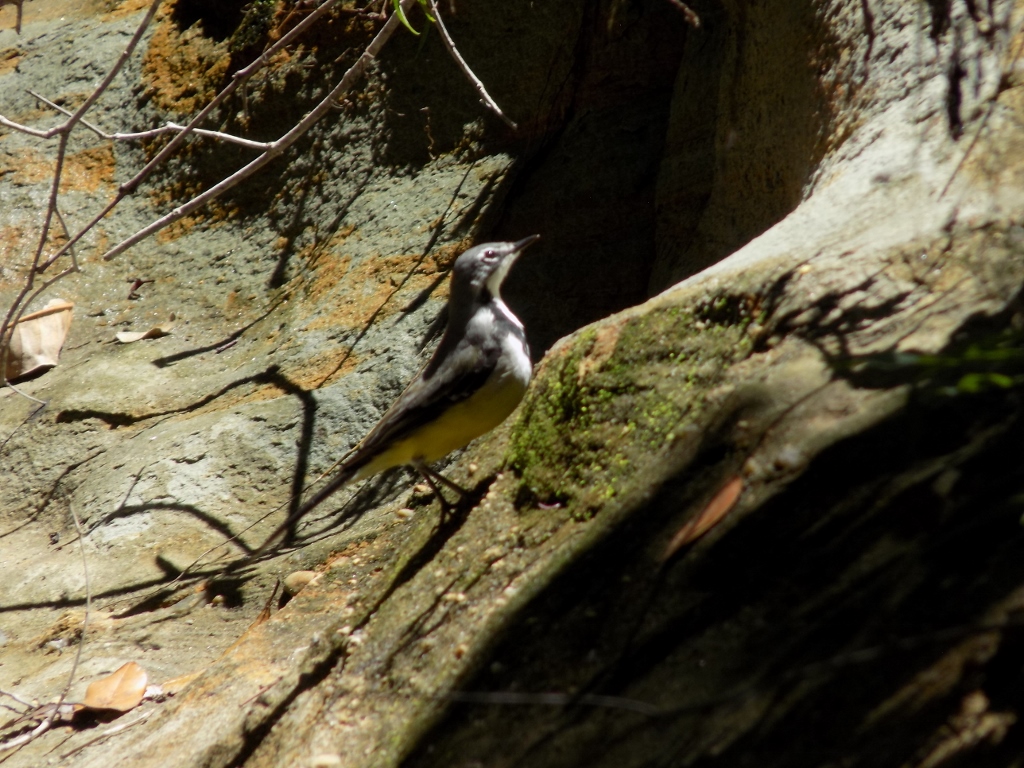 Madagascan wagtail
Madagascan wagtail
Still, the main reason why we headed along that “side” path was in order to get to yet another natural pool. When we were by the Blue and the Black Pools, apart from us there were not too many people, perhaps four or five of them, but here there were only the two of us and the guide. And the place was fascinating. With all my good will, though, the photos cannot even begin to convey the impressions one gets when in such a place.
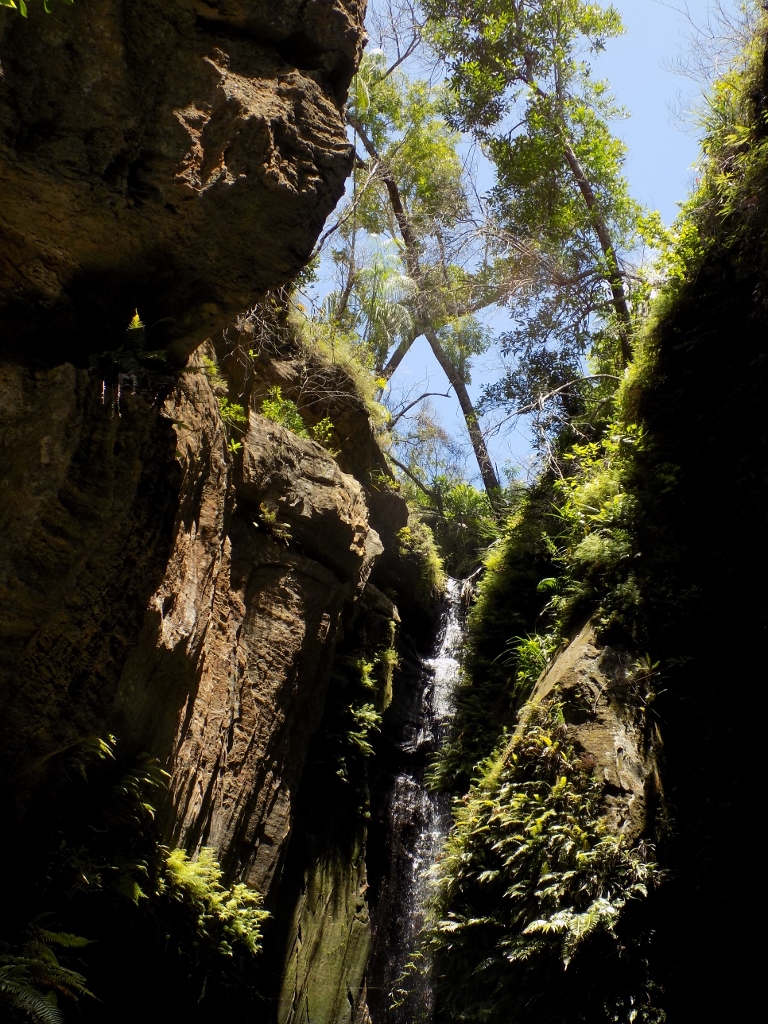 The place where there is another natural pool
The place where there is another natural pool
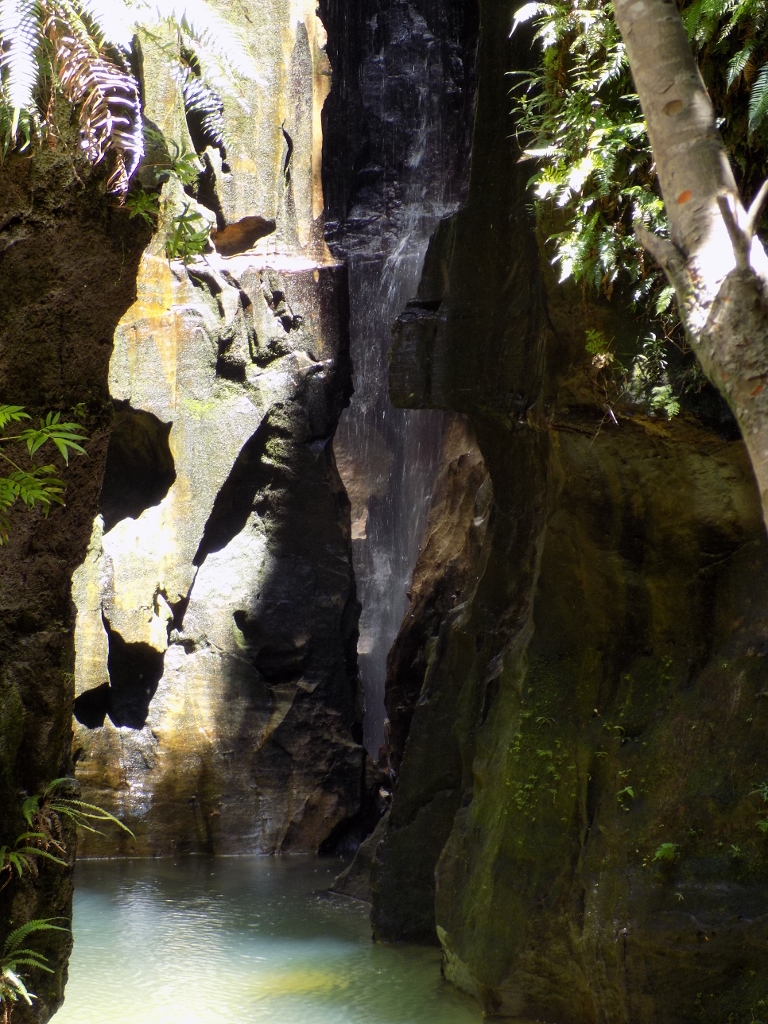 The place where there is another natural pool
The place where there is another natural pool
This is a miniature, comparatively high canyon in which river comes from the top creating a waterfall called the Nymphs’ Waterfall which is almost hidden by the vertical walls of the canyon. After the waterfall the river starts to meander between the canyon walls that soon spread a little thus providing the space for that natural pool.
In an attempt to illustrate the specificity of this place as much as possible, here is a short video recording:
Needless to say, when the guide asked us if we wanted to swim here as well, we did not hesitate even for a second, but rather started to take our clothes off immediately. Getting into the water was a bit trickier here than in the case of the Blue Pool; we had to go over some larger rocks that prevented us from entering the water gradually, while the water was just as icy. Still, now we were prepared, so the coldness of the water did not bother us too much and on the other hand we soon moved to the sunny section.
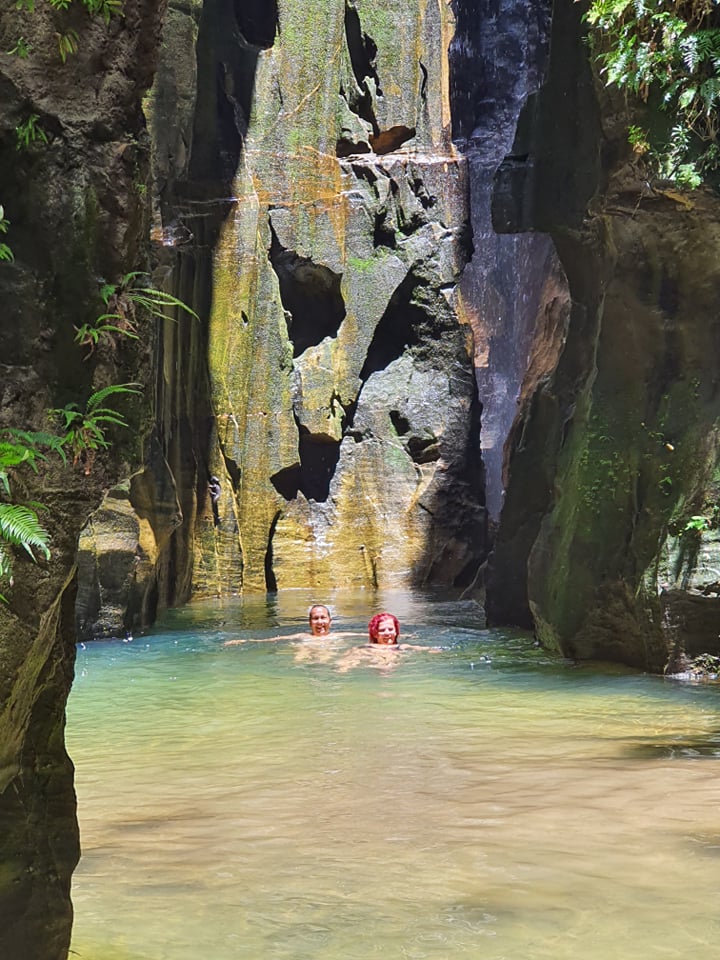
Enjoying the natural pool within Isalo NP (Photo: SM)
Right in the middle of the section that was lit by the Sun there was a sandy shoal, so the water was shallow, it was possible to sit there and it was also a little less cold. Still, after enjoying in the beauty of the place and the wonderful clean water, with the feeling of great privilege for having this fabulous opportunity to be here, to have such an experience and on top of it all to be alone and feel somehow quite special on account of that, we had to get out at some point, get dry again and put our clothes on.
While we were standing on those uneven and potentially slippery rocks where our things were, trying to balance successfully on one leg and then the other while putting our pants on, it turned out that Sneža had eyes like a hawk – looking at the beauty of the Nymphs’ Waterfall and the pool we had just gotten out of, she noticed something that was clinging to a vertical rock. We looked more carefully and saw that this was a chameleon. We had no idea how it got there. Still, we were not ready to take our clothes off and get into the water again with an intention to approach it and have a better view. This way, taking into consideration that it was far enough, we had problems zooming on it with our cameras and making the photos clear and sharp. I managed this only partially using my video-camera with which I made a couple of photos.
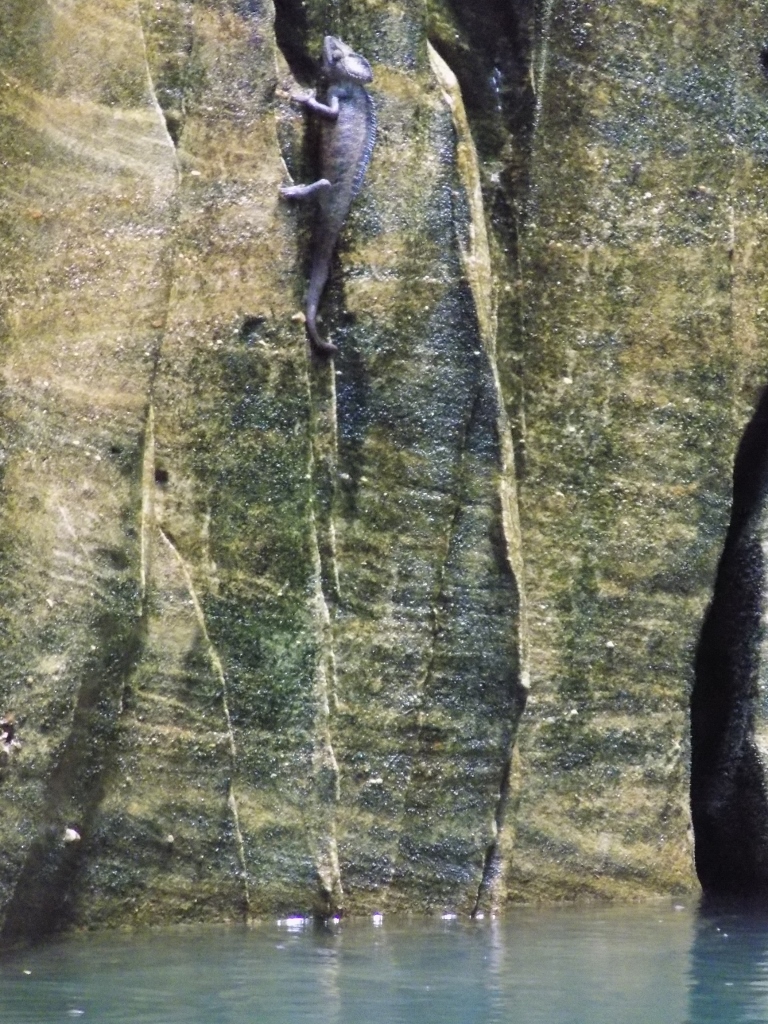 Chameleon on a vertical rock
Chameleon on a vertical rock
But, when I got back home and when I was sorting my photos out and writing this story, I noticed that the chameleon was in that same place even while Sneža and I were swimming, but at that time we did not notice it at all. If you look more closely, you can see it in the photo in which the two of us were in this natural pool.
Be as it may, the two of us were soon completely dressed and ready for the return. Going back along the side path, which was easier this time around since we were going down, we came to the main trail that followed the bigger river and soon we returned to the forested part. There we came across a very playful group of ring-tail lemurs. There is not much to tell here, but there is a little that can be seen.
Not far from here there was the camp for visitors I mentioned in my previous sequel. In the central part of a relative clearing within the forest, there was a large table with benches made of stones that was canopied and where lunches were organised for daily visitors. The food was probably provided by the people from the tourist section of the National Park. When we got there, a group of tourists started to gather around the table, but it was also possible for those that did not belong to that group to buy refreshing beverages which were brought here in large coolers. We certainly enjoyed getting refreshed with something nicely chilled, although we still had our own water supplies, so we sat at one of the smaller tables and benches made of stones which was slightly away from the central structure.
As we were finishing with our cool drinks and the group was starting with their lunch, numerous ring-tail lemurs began slowly to come out of the forest to this part and to gather here. They were obviously used to the presence of humans in that part, moreover, it was obvious that the visitors often fed them there. Thus, a lemur with its baby passed directly in front of my feet without any fear heading towards the big table.
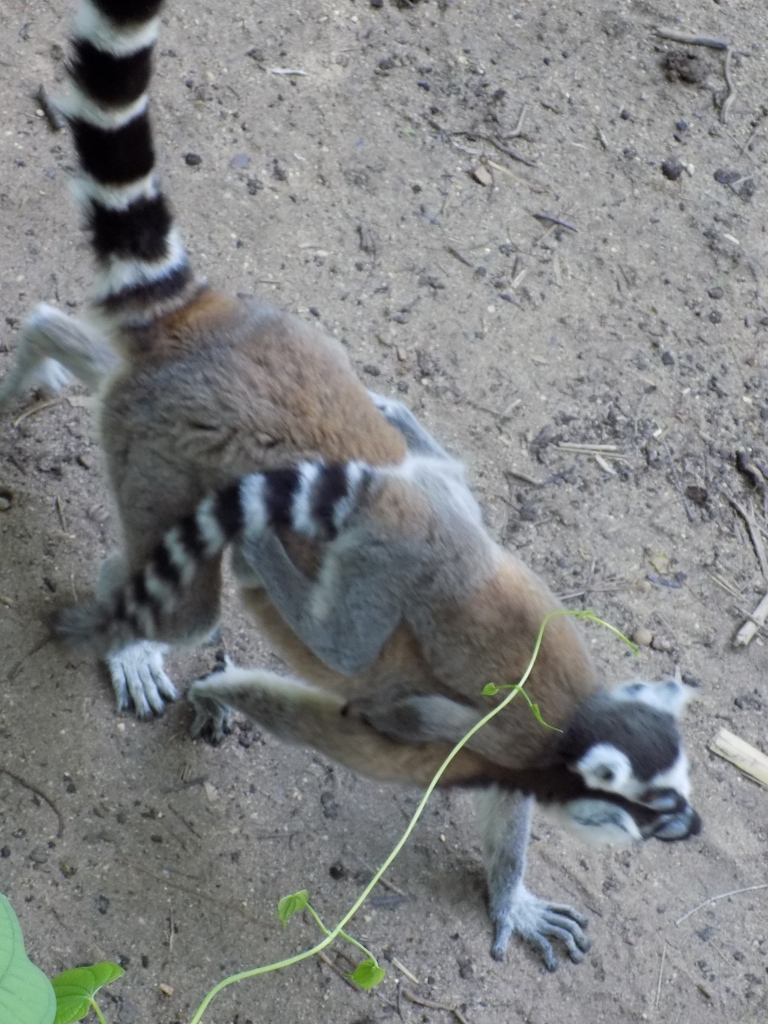 Like mesmerised, a ring-tail lemur is going towards the expected food
Like mesmerised, a ring-tail lemur is going towards the expected food
On a nearby rock there were a couple of adult lemurs with their offspring and I found it particularly pleasurable to take photos of them. Both pairs first sat there together, then one went away, while the other remained in the same place for a minute or two and then they went to get the expected food as well.
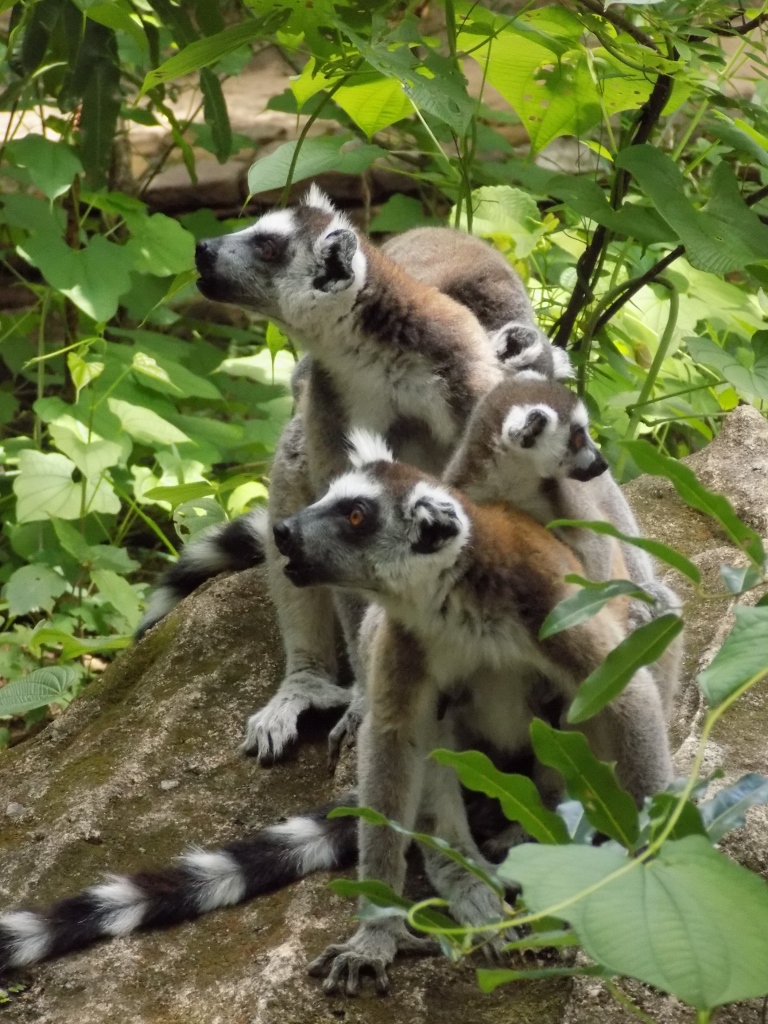 Two adult ring-tail lemurs with their offspring
Two adult ring-tail lemurs with their offspring
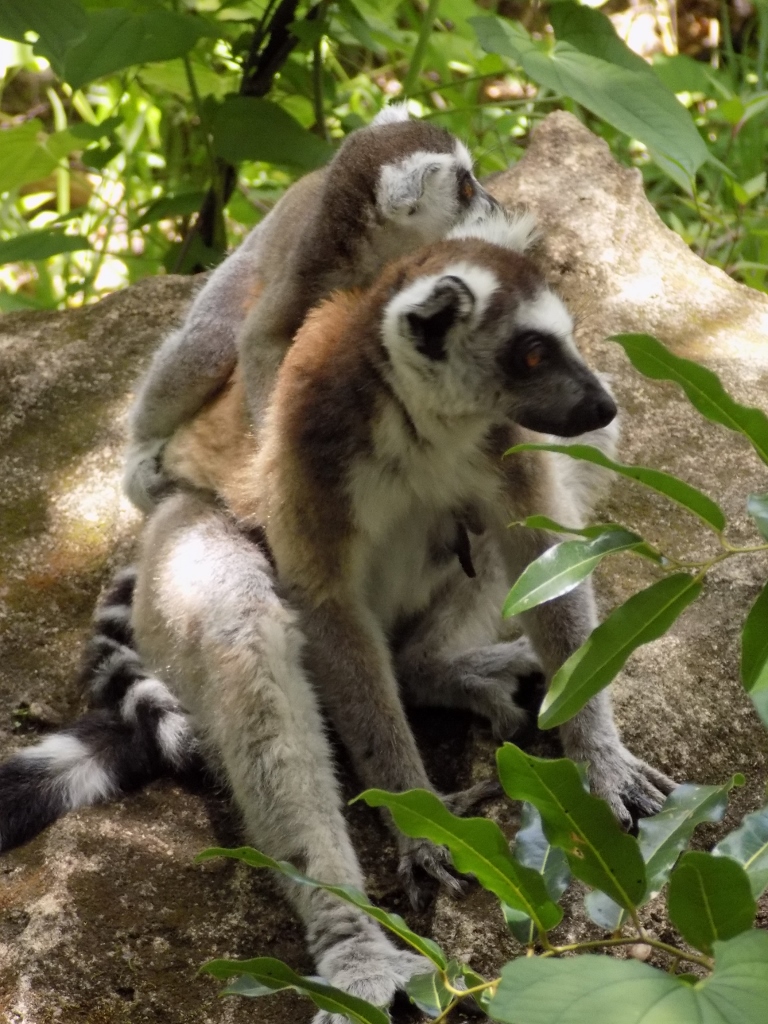 We are looking a little to the one side...
We are looking a little to the one side...
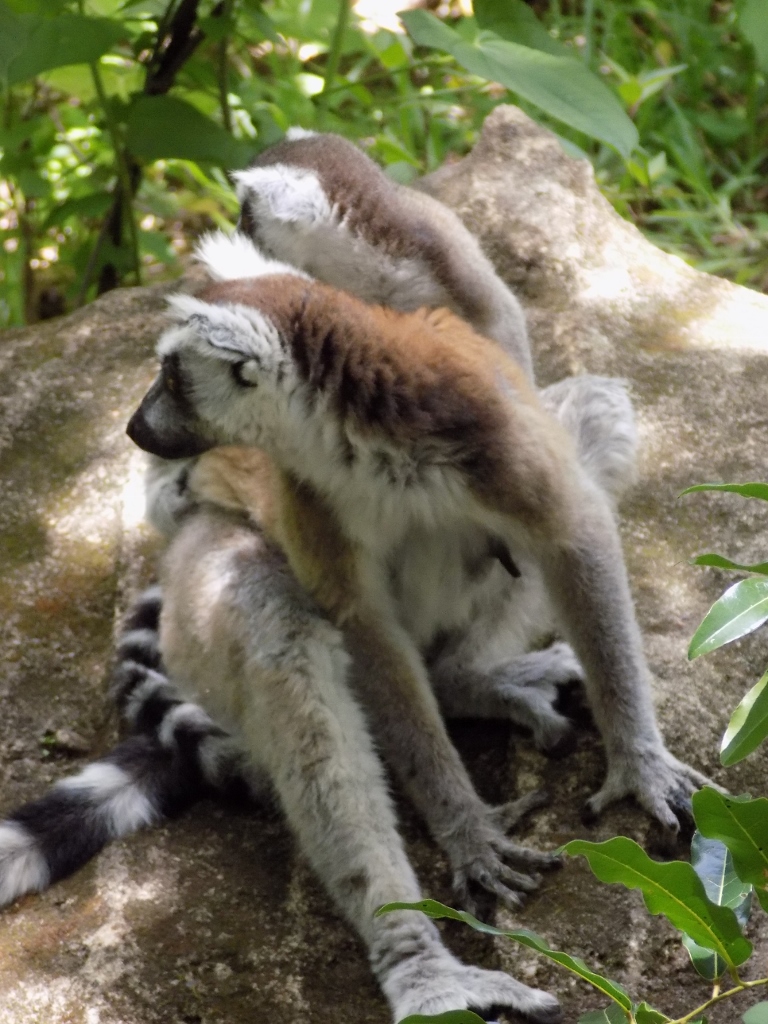 ... and then to the other
... and then to the other
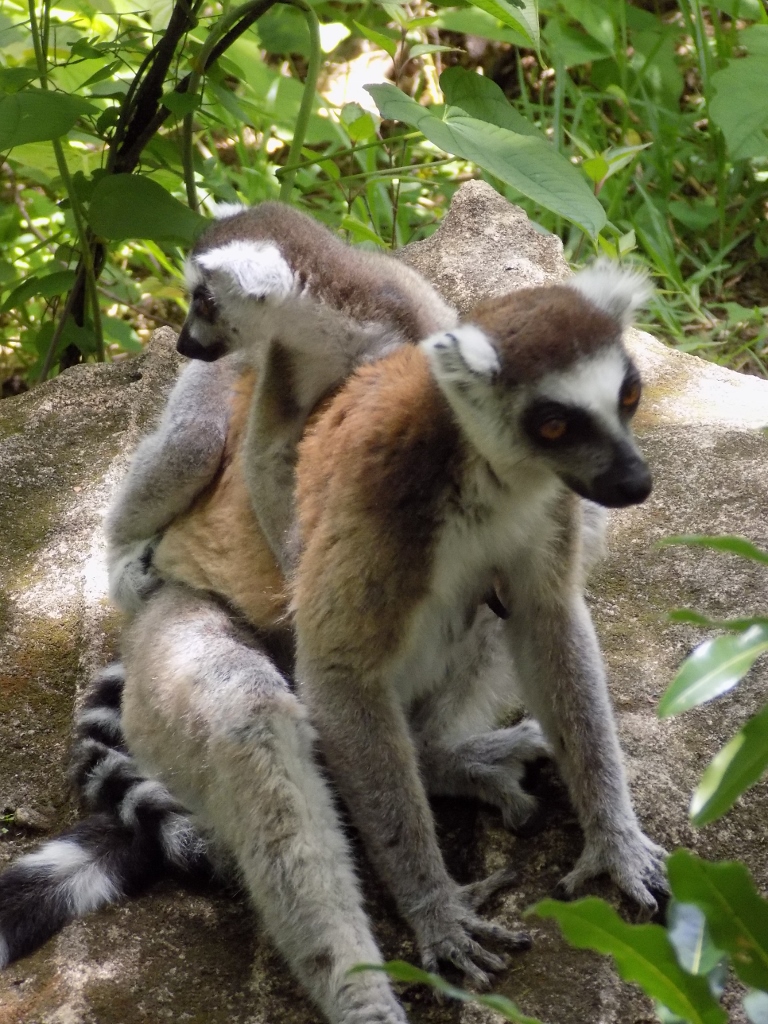 Now everybody is looking in any direction they like
Now everybody is looking in any direction they like
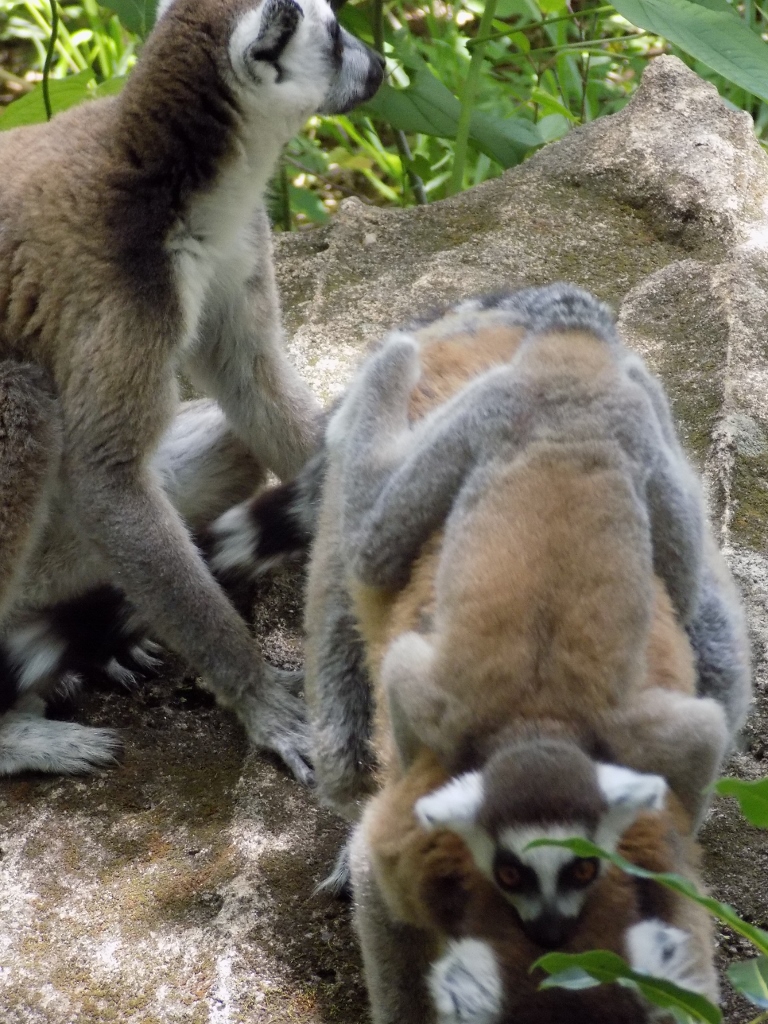 Enough of looking around, now let’s go and eat something
Enough of looking around, now let’s go and eat something
Meanwhile, another adult lemur came to that same rock and then it started to pose, too.
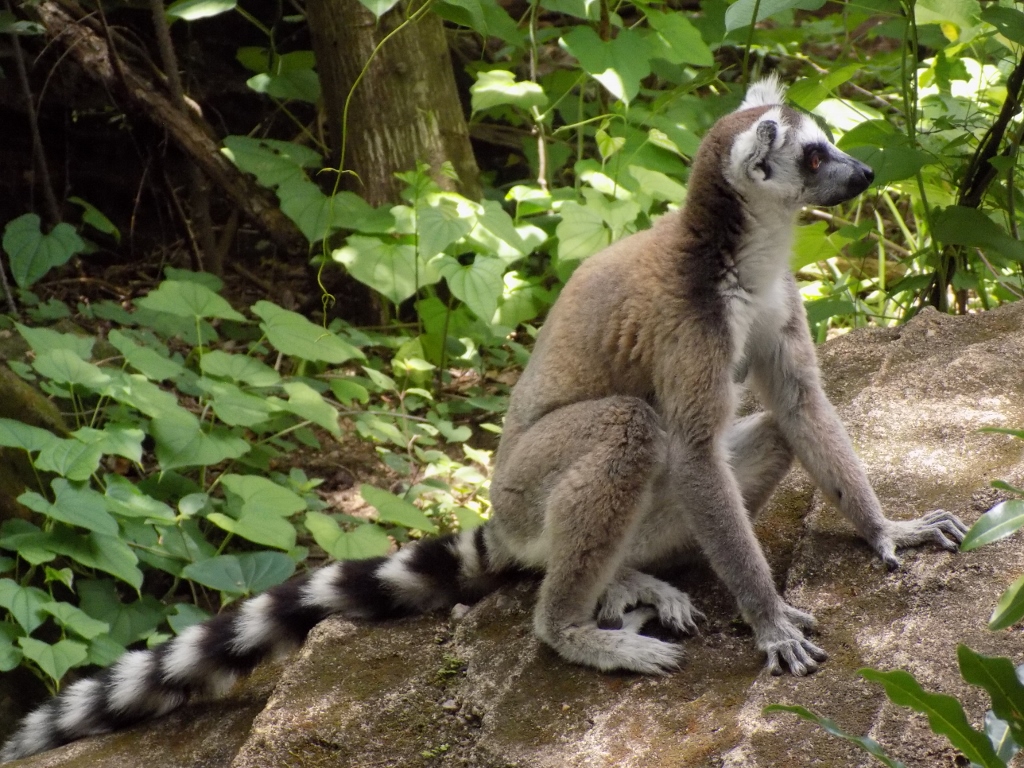 A ring-tail lemur
A ring-tail lemur
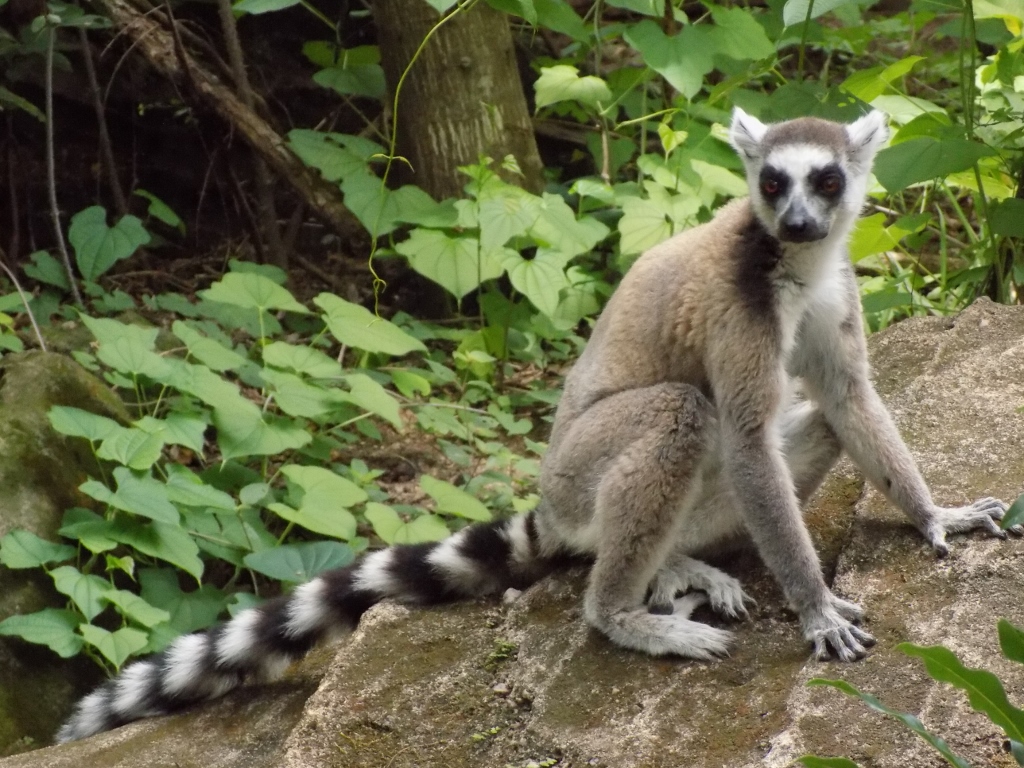 A ring-tail lemur
A ring-tail lemur
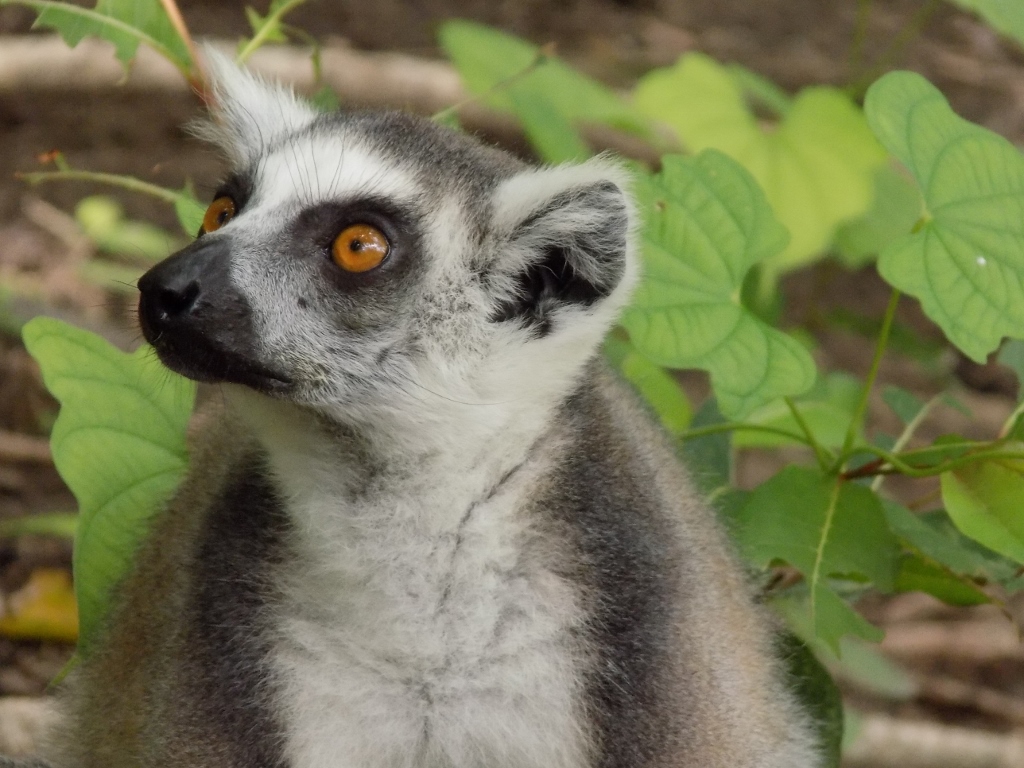 A ring-tail lemur
A ring-tail lemur
Then Sneža and I headed back towards our table where we had previously sat in order to remove the remaining bottles and take our things, so we saw another ring-tail lemur that was holding its tail nicely.
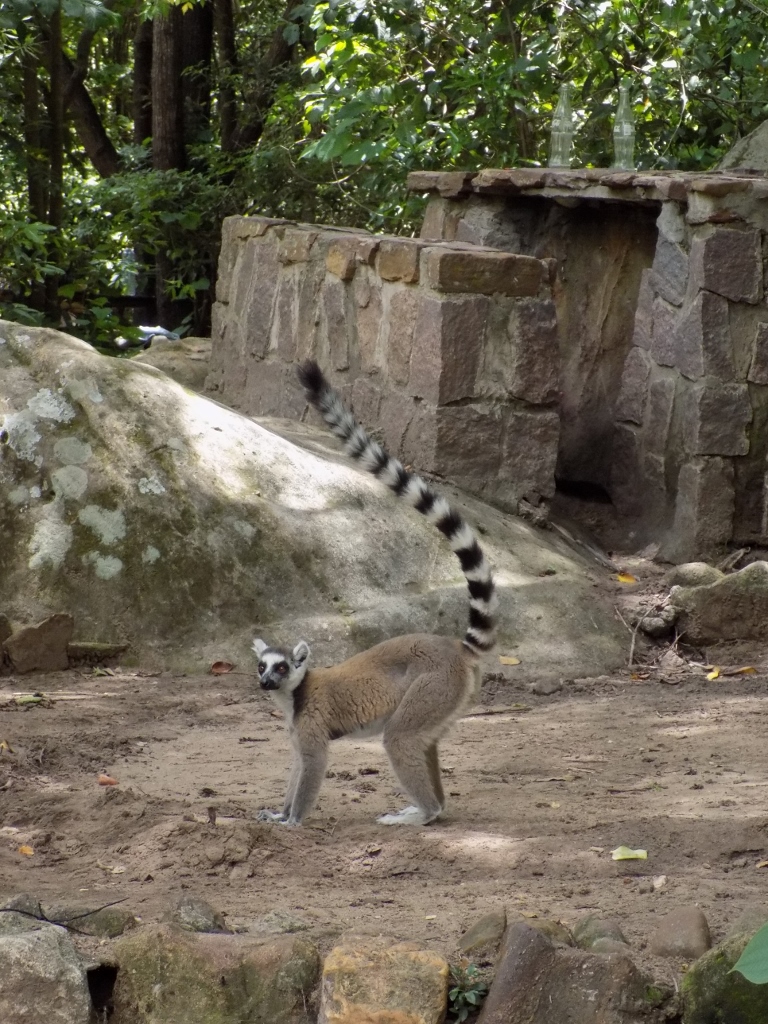 A ring-tail lemur
A ring-tail lemur
After this picturesque break, we continued walking and soon we got out of the forest leaving the wonderful canyons and natural pools in Isalo National Park behind us.
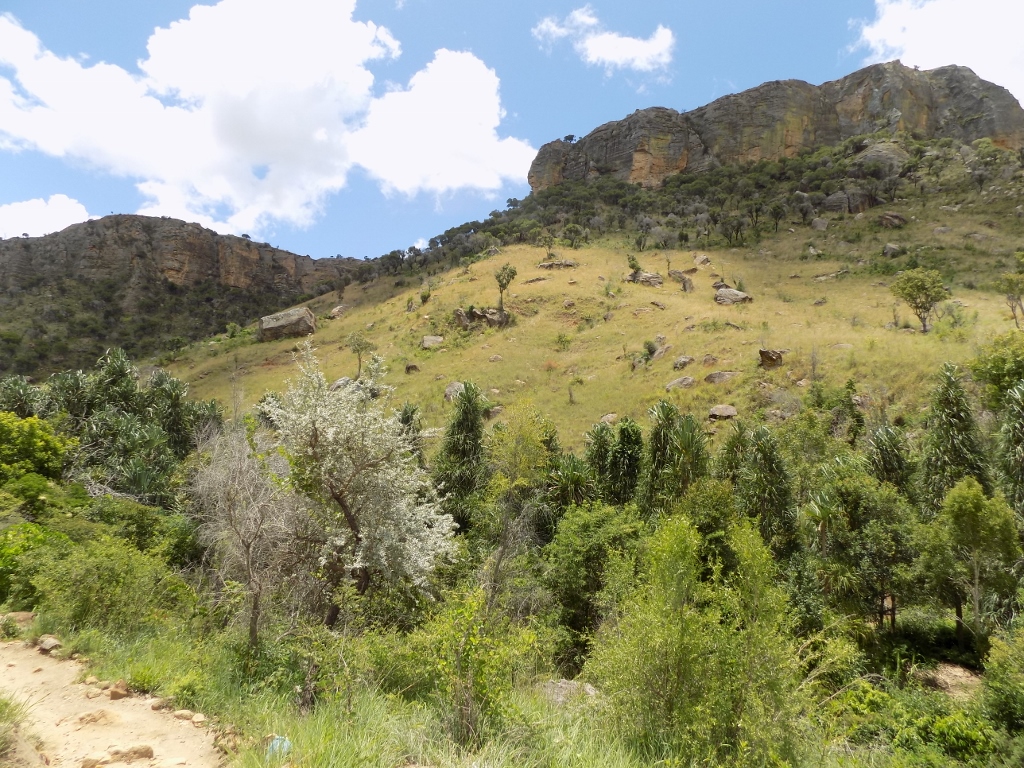 View towards the ridges at the beginning of the Namaza walking trail
View towards the ridges at the beginning of the Namaza walking trail
Along the way, the guide told us about some customs of the Bara people on whose territory Isalo National Park is located. Members of this people intensively breed the zebus and that is their most important activity. However, the most interesting and the most picturesque story by far concerns the custom related to the circumcision of the boys who are members of this tribe. Namely, as the guide told us, during the circumcision it is strictly forbidden (it is a taboo or “fady” as this is called on Madagascar) that the cut off piece of skin falls onto the ground, in addition to which the custom says that after the cutting off the piece of skin should be eaten by the boy’s grandfather! I don’t know what happens if perhaps the grandfather is not alive, but I did not feel like going into the subject any deeper.
In any case, there were other things in the surroundings that I found much more attractive. For instance, an olive bee-eater or Madagascar bee-eater (Merops superciliosus) and a red fody (Foudia madagascariensis), both on the same branch.
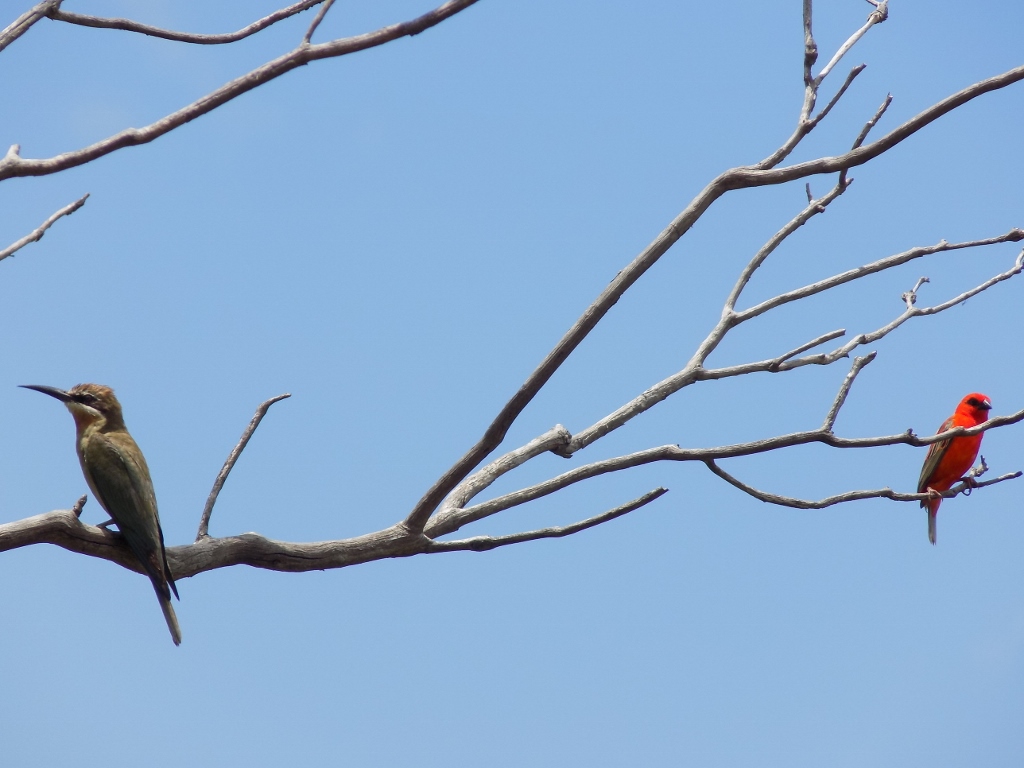 Olive bee-eater or Madagascar bee-eater and a red fody
Olive bee-eater or Madagascar bee-eater and a red fody
There we also passed by yet another small, but impressive reptile or a spiny-tailed lizard from the Uromastyx genus to be more precise. While it was cosily enjoying the heat of the rock, it was possible to see nicely its fascinating tail.
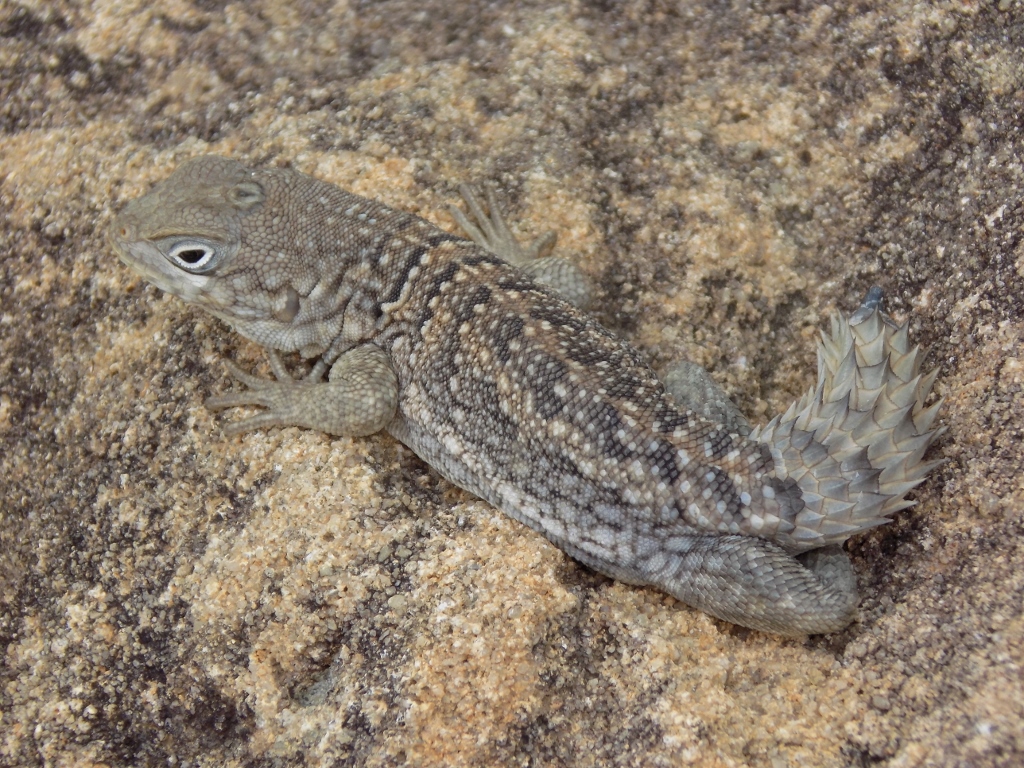 Spiny-tailed lizard
Spiny-tailed lizard
As we were leaving the section of the park in which there was the canyon, we could see in front of us the stunning landscapes of the plateau that surrounds Isalo National Park.
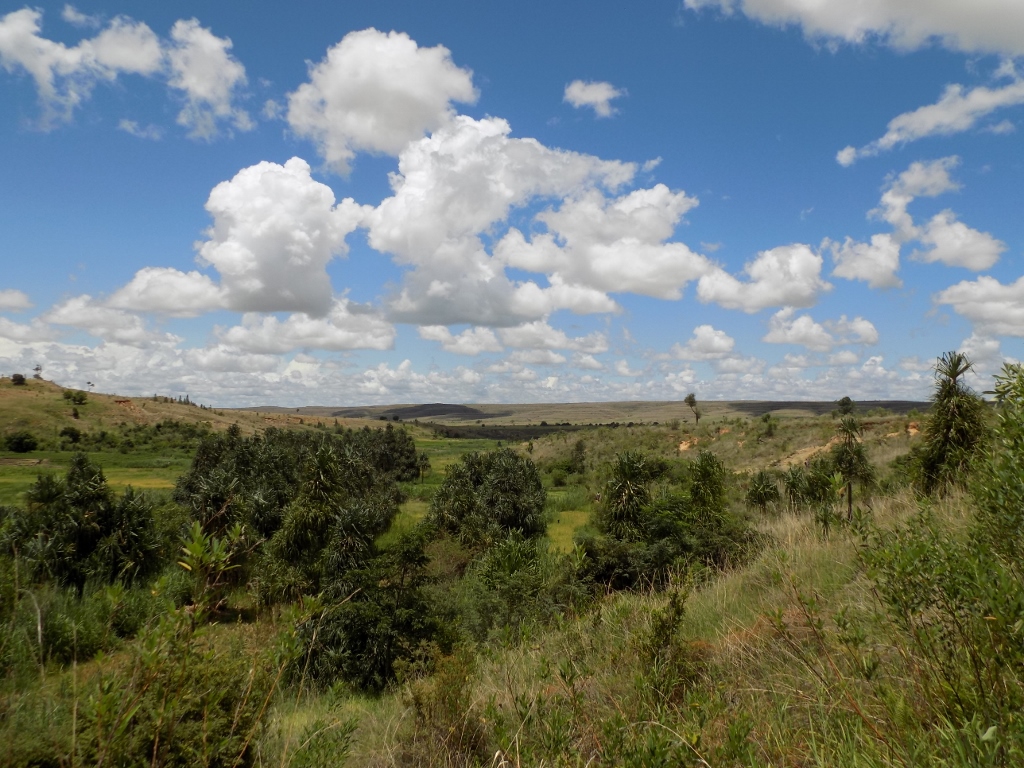 Plateau around Isalo National Park
Plateau around Isalo National Park
As it can be seen in the photo above, while we were busy walking around the national park, clouds had started to form in the sky. Still, when we got to the parking lot, our driver Rija was waiting for us and we all returned to the centre of small town Ranohira where we parted from our guide and then went for lunch.
As usual, in the restaurant we chose a table that suited us best (it was outside, but in the deep shade), while Rija went to another part of the same restaurant to have lunch there. Although his food and accommodation were included into the rental of the car with driver, since the two of us were in a particularly good mood this time, we decided to treat him with lunch, thinking that in this way he could keep the money that otherwise he would use to pay for his meal. However, it turned out that all the drivers automatically get their lunch at the restaurants to which they bring visitors. By the way, Rija loved rice and he kept emphasising that if he got a large portion of rice that would be enough for him and he would be pleased. On the other hand, although he gladly accepted snacks we would offer while in the car, he absolutely always refused bananas since, as he told us, he got fed up with them during his childhood. Apparently, when he asked for food, his mother would regularly offer bananas instead. There, childhood traumas can differ a lot from one case to another.
After the lunch, we returned to our hotel for a brief afternoon respite with an intention to consider again a little later the possibility of going to the “Isalo Window” rock formation. However, on this day, later in the afternoon, there were even more clouds than the previous afternoon.
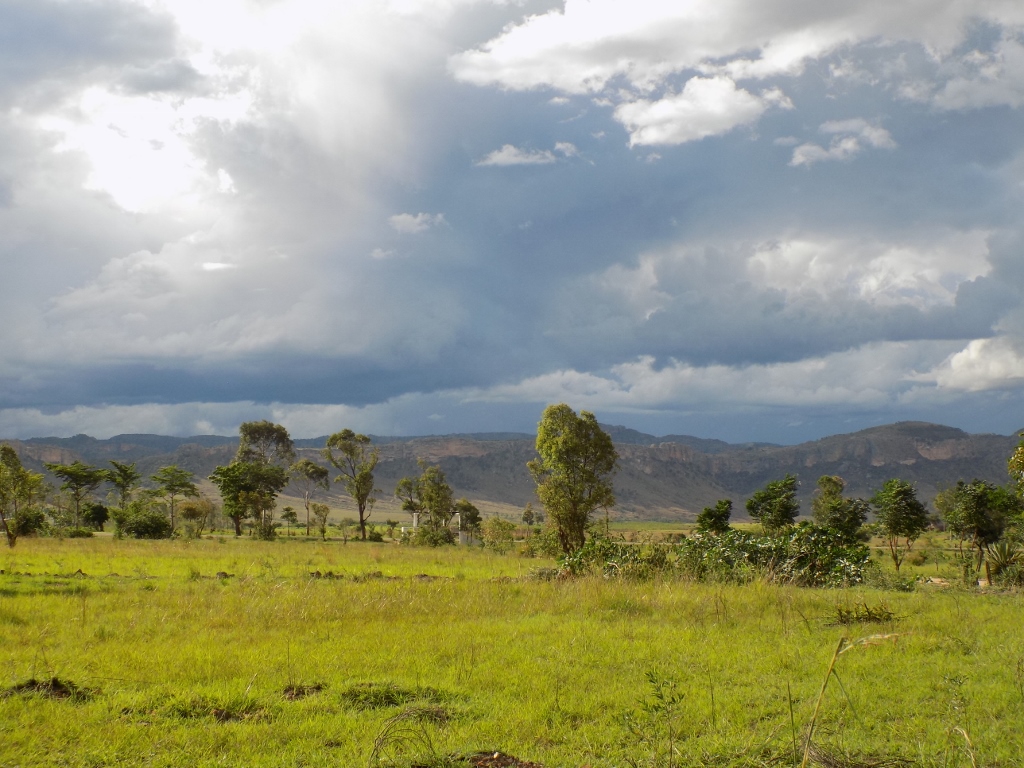 Sky above Isalo National Park
Sky above Isalo National Park
And not only was the entire sky covered in clouds, but also these clouds were dark which suggested rain and thus there was nothing else for us to do but to stay at the hotel.
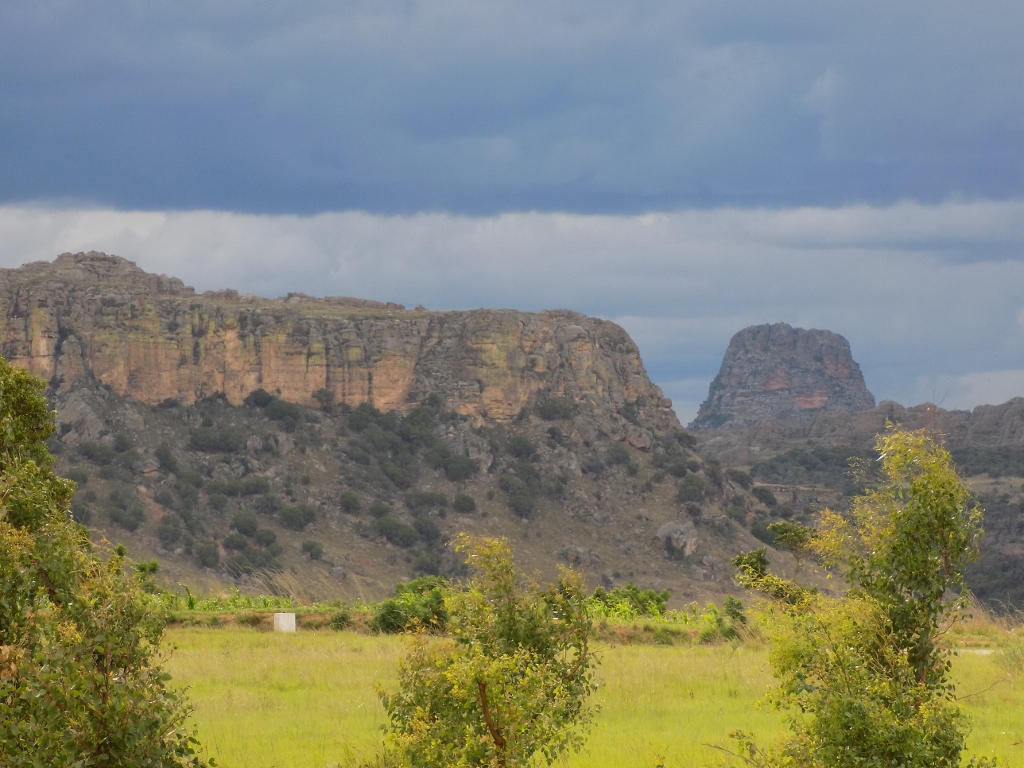 Dark clouds above Isalo National Park
Dark clouds above Isalo National Park
That afternoon, both Sneža and I went to the hotel’s pool and swam there a little, after which she went back to the room, while I stayed by the pool lying on a bed. Still, at some point it started to rain and very soon this turned into a proper downpour, so I quickly grabbed my things and ran back to the room. When I peeked from our bungalow a little later, I could see that all the paths and a good share of the yard were covered in water.
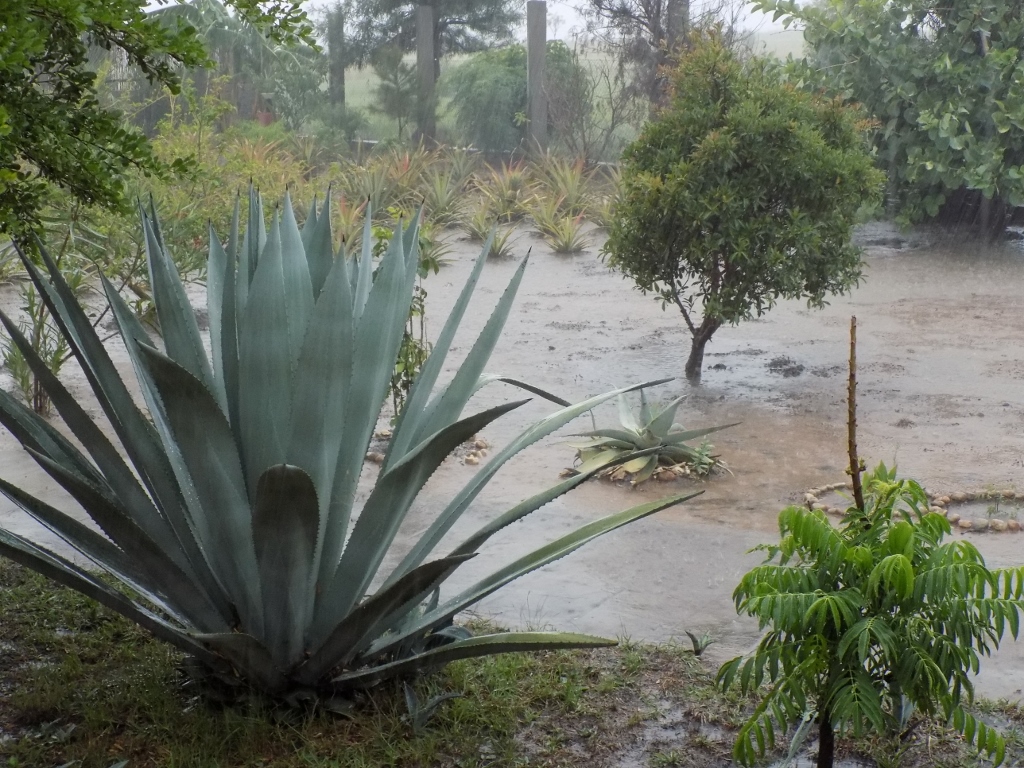 Path in front of our bungalow and a part of the hotel’s yard during the rain
Path in front of our bungalow and a part of the hotel’s yard during the rain
Still, at some point the rain stopped and although the clouds were still very much present, people could get out into the open for a little while without fear that they would get drenched.
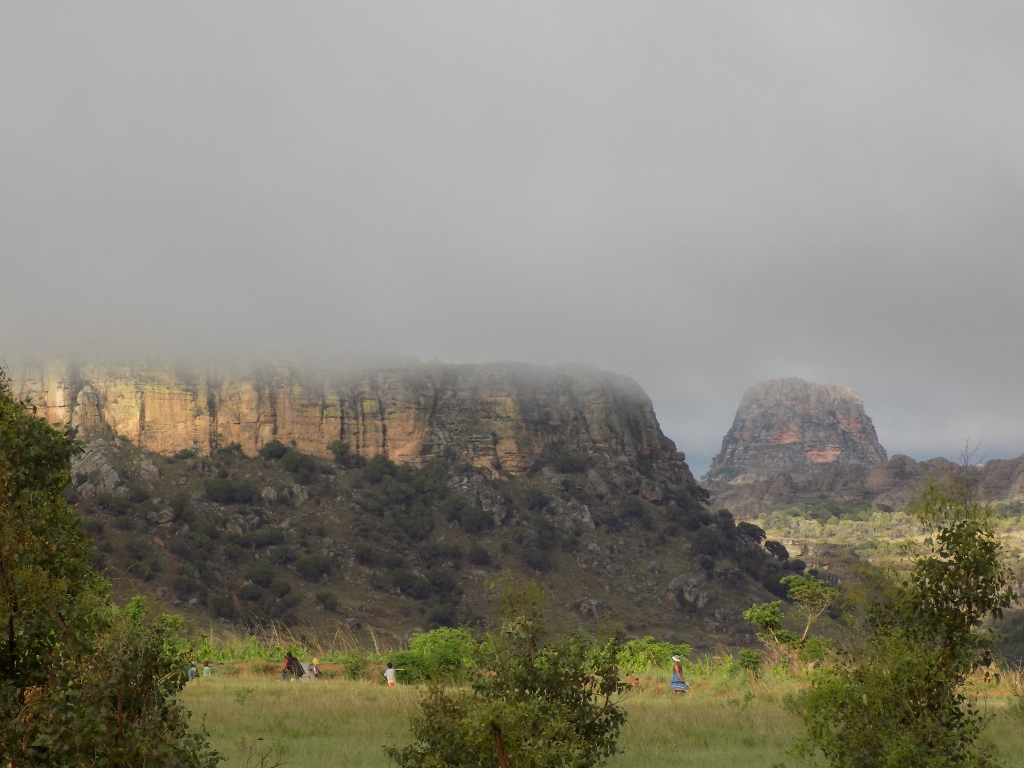 Clouds above Isalo National Park
Clouds above Isalo National Park
We had a very quiet evening that day and went to bed early, since already the next day after breakfast we were to continue with our journey. Still, as I was again walking around the by now completely dry yard of the hotel, I took a photo of an endemic plant from Madagascar which specifically grows precisely in the south of this country. This is a type of a succulent plant with the Latin name of Alluaudia procera.
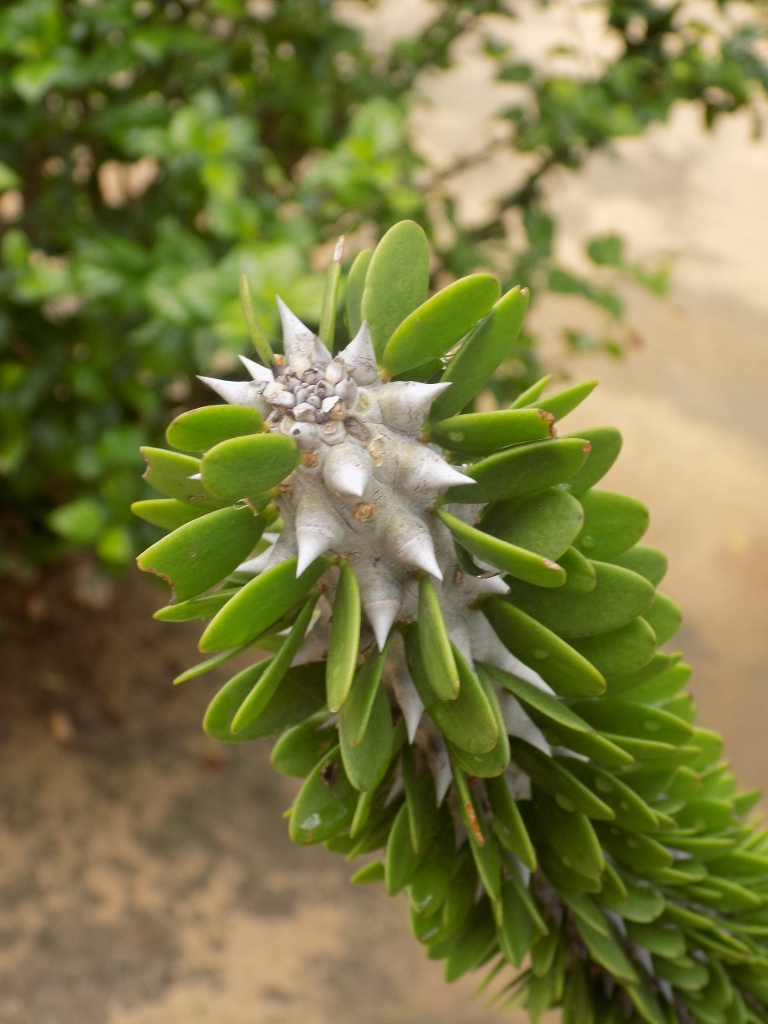 Alluaudia procera
Alluaudia procera
We also took the presence of some people in the parking lot and asked them to take a photo of the two of us with Rija and the car by which we were touring Madagascar.
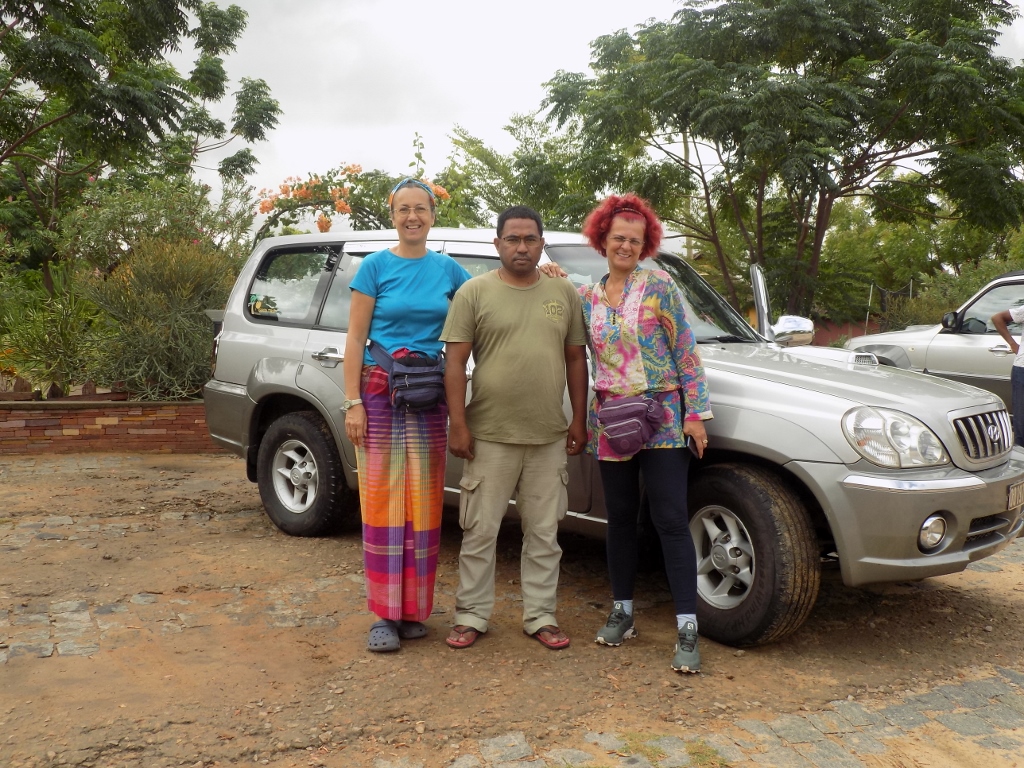 With Rija and the car
With Rija and the car